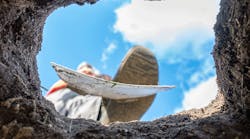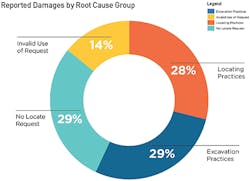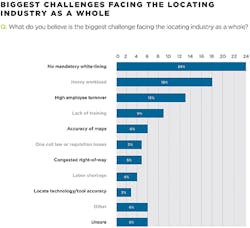Latest from Featured
3 Data-Driven Recommendations for Telecom Providers —
Establishing an effective damage prevention program is more important than ever, as damages to buried infrastructure are on the rise in the US. The Common Ground Alliance (CGA) is dedicated to preventing damage to underground utility infrastructure, and to protecting those who live and work near these important assets. CGA analyzes data from industry stakeholders to provide detailed recommendations for ways to improve the damage prevention process, which your organization can consider implementing to strengthen your damage prevention program and to help drive damages down.
Best Practices Exist for a Reason
According to CGA’s DIRT Report, the estimate of total damages in the US in 2019 increased 4.5% year-over-year to 532,000 — at a staggering societal cost estimated at $30 billion. The report shows that "no locate request" and "excavation practices" are the biggest root cause groups for damages, each accounting for 29% of damages.
InvisiLight® Solution for Deploying Fiber
April 2, 2022Go to Market Faster. Speed up Network Deployment
April 2, 2022Episode 10: Fiber Optic Closure Specs Explained…
April 1, 2022Food for Thought from Our 2022 ICT Visionaries
April 1, 2022Breaking down the "excavation practices" group shows that some of the biggest root causes of damages are actually addressed by existing CGA Best Practices that cover facility avoidance and tolerance zones (Practices 5.14, 5.19 and 5.20). A key recommendation from that report focuses on the importance of increasing adherence to Best Practices like these that are proven to prevent damages. The "excavator failed to maintain clearance after verifying marks" and "excavator dug prior to verifying marks by test hole (pothole)" root causes together account for nearly 19% of total damages, and within the excavation practices root cause group, they account for 64% of damages.
Recommendation #1: This data shows that promoting the importance that your excavators use Best Practices like potholing, for example, through training programs or other initiatives, can strengthen your company’s damage prevention program and reduce the likelihood that damages will occur.
Pressures Mount
Another recommendation from the 2019 DIRT Report’s analysis of damage data was that the damage prevention industry should examine the pressures on locate technicians — a topic that is explored in depth in CGA’s Locator White Paper. It analyzes primary research CGA conducted among US-based locate technicians and locating industry decision-makers to provide valuable insights into the challenges facing locating stakeholders specifically, as well as potential solutions to improve the damage prevention process as a whole and to reduce damages.
One important takeaway: the percentage of damages attributed to locating root causes rose to its highest level last year, accounting for 28% of all damages. (See Figure 1.)
Figure 1. The root cause groups for damages to underground facilities that occurred in 2019 and were reported into CGA’s Damage Information Reporting Tool (DIRT). (Source: 2019 CGA DIRT Report)
Similar to the 2019 DIRT Report, the Locator White Paper reinforces the immediate impact that widespread adoption of existing Best Practices could make. In CGA’s survey of more than 400 US-based locate technicians, 97% of respondents said making white-lining mandatory would be effective in improving the likelihood of accurate and on-time locates, and 97% said increased communication between the excavator and locate technician would be beneficial. (See Figure 2.)
Figure 2. In an online survey conducted in December 2019, CGA asked more than 400 US-based locate technicians how effective various actions would be in improving the likelihood of accurate and on-time locates.
In the online survey, locators identified a lack of mandatory white-lining as the #1 biggest challenge facing the locating industry as a whole. (See Figure 3.)
Figure 3. The top challenges facing the locating industry as a whole, according to the 402 US-based locate technicians who completed CGA’s online survey conducted in December 2019.
CGA’s in-depth interviews with 20 locating industry decision-makers showed agreement with the locate technicians, with 19 of 20 of the interviewees saying white-lining solves locate ticket issues by narrowing ticket scopes or size.
Recommendation #2: The adoption of practices like white-lining (Practice 5.2) is a solution that both facility owners and excavators can implement immediately. If white-lining isn’t already part of your damage prevention training, consider incorporating it into your program to help increase communication and to improve the likelihood of accurate, on-time locates — and safer excavation outcomes.
The Roadmap
Not surprisingly, 99% of locate technicians said updated facility maps would be effective in improving the likelihood of accurate and on-time locates. Technicians also identified inaccurate and outdated maps as a significant challenge facing both them and the industry.
The interviews with locating decision-makers mirrored the survey responses: every interviewee believes that updated maps would improve locate efficiency, with 15 of 20 stating it would be very effective.
The interview participants also identified both white-lining and updating maps as being more effective than a range of other solutions.
Recommendation #3: If your company hasn’t provided updated facility maps to the one-call centers in the areas you serve, doing so will provide locators with the best available information to help ensure more accurate and timelier locates, benefitting both locators and excavators who work around your facilities and ultimately protecting your assets by reducing the likelihood of damages.
Data shows that implementing these 3 recommendations can strengthen your company’s damage prevention program — from promoting the use of Best Practices like potholing and white-lining in your training programs and initiatives, to providing updated maps of your facilities to stakeholders. All of these can have an immediate effect and can lead to better safety outcomes for all parties involved in the damage prevention process.
The data shows that if we work collectively toward attainable solutions, we will significantly reduce damages to critical underground infrastructure, as well as protect those who live and work near those important assets.
Resources and Notes
This article was created from the following sources:
Damage Information Reporting Tool (DIRT) Report
CGA White Paper, "Insights into Improving the Delivery of Accurate, On-Time Locates"
For more information about the DIRT report, visit https://commongroundalliance.com/DIRT. For more information about CGA, please email [email protected].
Follow Sarah on Twitter @skmagruderlyle, and follow CGA on Twitter @CGAConnect.
Like this Article?
Subscribe to ISE magazine and start receiving your FREE monthly copy today!












